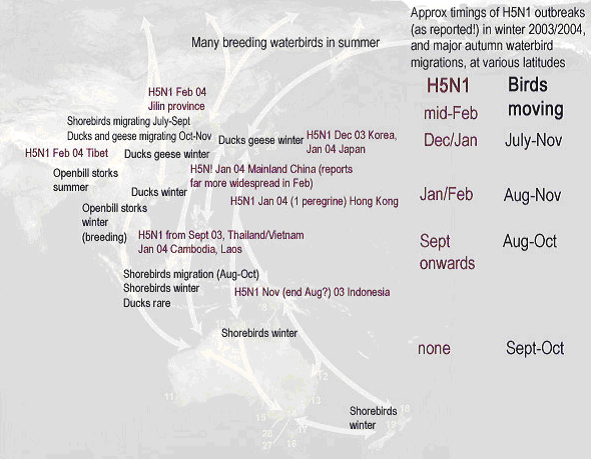
|
||||||||||||
|
||||||||||||
|
||||||||||||
|
||||||||||||
|
||||||||||||
|
||||||||||||
|
|
||||||||||||
|
|
|
|
| Dead Ducks Don't Fly | |
| Notions that migratory birds are responsible for spreading the New 'n' Nasty H5N1 Bird Flu Variant around Asia are quackers (chiefly looking at 2003/2004 outbreaks). | |
The timings of the outbreaks and bird migrations are wrong; detailed migration routes and distributions are wrong; the new variant is lethal to wild birds too - it has killed some, but though thousands of evidently healthy wild birds have been tested, none (or only one) has yet been found to be carrying the new and nasty H5N1 variant (Genotype Z). There's no denying wild birds host flu; some 15 basic forms (strains) have been discovered. Ducks and geese are the main birds that flu viruses have been found in - maybe that's not surprising given they're prone to congretate for long periods and live on open water and marshy grasslands, and the fact that in them, the viruses transmit via faeces. But these natural viruses seem to have little impact on wild birds (till recently, the only incident known when bird flu caused extensive wild bird deaths was amongst common terns, in South Africa in 1961). |
|
 |
|
This should help show why it's ridiculous to blame the rapid spread of the H5N1 variant on east Asia's migratory birds. The gist of the argument is summarised on the right of the map - birds wintering in the south had departed South Korea and Japan before their outbreaks began; hadn't even arrived in southern areas (especially Indonesia) as outbreaks began there. And China (crossroads for most of the migration routes) didn't even report outbreaks till January, well after the autumn migration had ended. In the west of the area are openbill storks, which nest at a few colonies in Thailand, during winter. Some died this winter, and even before testing positive for H5N1 (which was reportedly identified in three carcasses) this incident was taken as evidence for migratory birds spreading bird flu. Trouble is, they migrate from Bangladesh/NE India; and they feed in fields within one of Thailand's worst-hit regions - making it surely the case that local poultry farms were the source of the virus; they were victims. The migratory-birds-are-to-blame case crumbles even further when you consider that thousands of migrants have been tested for H5N1, yet not one healthy bird has yet tested positive. All wild birds that have tested positive have been dead (or dying). And dead ducks don't fly. |
|
| Extracts from an article by Dr Martin Williams. Click here for the full article. | |
| For more on bird flu see Dr Martin Williams information page. | |
| Related pages: Geographical spread of H5N1 , Wild Birds and Avian Flu | |
|
|||||
| Support thaibirding.com by using the above websites. | |||||


Copyright © 2004-2007 thaibirding.com. All rights reserved.
